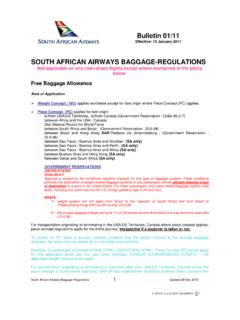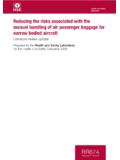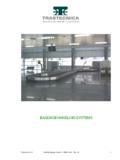Transcription of Baggage handling in narrow-bodied aircraft: …
1 EAST & SOUTH EAST SPECIALIST GROUP. Baggage handling in narrow -bodied aircraft : Identification and assessment of musculoskeletal injury risk factors. Authors: Sarah Tapley HM Inspector Health and Safety (Ergonomics). David Riley Senior Ergonomist, Health and Safety Laboratory January 2005. Crown copyright TABLE OF CONTENTS. 1. Summary 3. 2. Introduction 4. 3. Project Aims and Objectives 4. Aim 4. Objectives 4. Methodology 4. 4. Background 5. MSD Incident Data 5. Industry Passenger Bag Weights Initiative 5. 5. Literature Review 6. Manual handling Injury Risk Factors 6. Baggage handling Specific Literature 6. Physical Research 7. Summary of Baggage handling in Hold 8. Research/Publications General handling in Low-Headroom Literature 8. Implications for Baggage handling 10.
2 6. Baggage handling Operations Assessments 11. The Load 11. The Individual 13. The Environment 13. The Task 13. Pushing/Pulling Baggage Carts 22. Pushing/Pulling Belt Loaders 23. 7. Summary/Conclusion 23. 8. Risk Reduction Measures 23. 9. Recommendations 24. Short Term 24. Medium/Longer Term 24. Recommendations for Further Research 24. 10. References 25. LIST OF TABLES. Table 1 MSD Injury data statistics 5. Table 2 MAC scoring for one operator outside the aircraft 12. Table 3 MAC scoring for one operator inside the aircraft hold 12. Table 4 Loading bags from cart to belt loader 14. Loading bags from cart direct to 200 series front hold with no belt Table 5 15. loader Table 6 General observations 16. Table 7 Transferring bags from the hold door to the in-hold stacker 17.
3 Table 8 For single worker in hold general observations 18. Table 9 Worker un-stacking in hold 19. Table 10 Worker transferring bags from the in-hold stacker to the hold door 20. Table 11 Unloading from hold to flat bed lorry with belt loader 21. Table 12 Unloading from hold to flat bed lorry - handler on lorry 21. Table 13 Unloading from hold to flat bed lorry - handler on lorry 22. Table 14 Force measurements for pulling Baggage carts 22. Table 15 Force measurements for pulling manual belt loaders 23. 2. Research indicates that the manual loading and unloading of Baggage onto narrow -bodied aircraft has been identified as a high risk operation for more than 20 years but little had been done in the UK to address the issue to date. The aviation industry, however, has recently adopted a voluntary 32kg single bag weight limit, which appears, according to industry figures to be reducing the numbers of reported incidents.
4 The aim of this project was to re-examine the musculoskeletal risk factors and potential risk reduction measures associated with this manual Baggage handling operation. There is mixed opinion as to whether it is better to handle in confined spaces when stooped or when kneeling. A review of the literature would, on balance, indicate that handling while kneeling for short periods inside the hold would be preferable to handling while stooping. The highest risk elements of the task are during the internal Baggage handling operation, especially the stacking of bags during the on-load operation. Repetitive handling of bags and with the hands at a far distance from the low back are also high risk factors. Unloading Baggage onto flat bed lorries with a handler stood in the hold doorway also represented a high risk of injury.
5 At some airports equipment has to be pulled and pushed into position exposing staff to associated risks. A range of immediate risk reduction measures have been identified including the use of belt loaders for all Baggage loading and unloading operations, job rotation to decrease exposure to the highest level of risk and better labelling of bags. Longer-term risk reduction includes establishing an industry forum to identify and review equipment and methods to reduce the risks, passenger education and reduction in the bag weight limit based on robust research. 3. 2. Introduction Musculoskeletal Disorders (MSD's) are responsible for 40% of all personal injury incidents at airports reported to HSE, of this figure the majority are reported by ground handlers. The loading and unloading of passenger bags onto narrow bodied aircraft for passenger usage has been of concern to both the air industry, HSE and other European enforcement agencies for many years now.
6 HSE field intelligence has highlighted a variety of different methods used to load and unload these aircraft . However there has been little evidence that the task has been assessed adequately. Assessments have failed to assess all the relevant risk factors and so ensure the risk is reduce to a level as low as practicable. Many assessments have concentrated on the height of the aircraft sills to decide on the work method. HSE and the air transport industry are working closely together via the Revitalising Health and Safety in Air Transport (RHSAT) Strategy group. This group was established to work in an integrated manner to achieve the targets set out in the revitalising health and safety statement. This report has been commissioned by the Air Transport Sector in HSE to identify the MSD risk factors present during loading and unloading of 737 series aircraft .
7 This information is intended to allow both HSE and industry via the RHSAT steering group to choose work methods to ensure risks from Baggage handling are reduced as far is as practicable. The findings and recommendations would also be useful to inform risk assessment for other narrow -bodied aircraft . 3. Project aims and objectives. Aim: To identify the MSD risk factors present during the manual loading and unloading of 737 series aircraft . This will provide information to ensure best working practices are utilised to reduce the risk of manual handling injuries to staff when loading and unloading 737 series to a level as low as reasonably practicable. Objectives: 1. To identify physical risk factors when loading/unloading outside the aircraft ;. 2. To identify physical risk factors when loading/unloading inside the aircraft .
8 3. To identify physical risk factors from pushing and pulling activities during the loading/unloading operation;. 4. To identify risk reduction measures. Methodology: Observation was used to gather data, including dimensions and force measurements, video recordings, and interviews with staff during fieldwork carried out at 3 UK airports observing low cost operations. Complete turnarounds (off-load and onload) were observed for the following aircraft : 737/800; 737/200; 737/300; 737/700. Pulling forces were measured using a calibrated Mecmesin dynamometer. Pulling forces were recorded three times and average force calculated. Assessments were made using the Manual handling Assessment Chart (MAC) . The MAC was developed, using ergonomics and medical research, to assist in making an initial assessment of the physical risk factors for manual handling injuries (Monnington et al 2002,Tapley 2002).
9 4. 4. Background MSD incident data Standard Industrial Classification (SIC) codes are used as a reference when recording work activity. Data collected by HSE from reports made under RIDDOR (Reporting of Injuries, Diseases and Dangerous Occurrences Regulations 1995) are coded under the main activity; this means some accidents will be coded for specific activities such as catering, security etc., rather than SIC 63230 for Supporting Activities to Air Transport. SIC 62100 etc refers to a series of codes covering scheduled and non-scheduled passenger and freight air transport. The figures quoted are official HSE data for accidents coded under the specific SIC codes. We are aware that the total number of accidents at airports is likely to be higher than the quoted figures, but can only give the validated data allowed by the HSE data recording system.
10 Most of these MSD reports relate to manual handling of Baggage and cargo onto/off dollies and trailers and into/out of aircraft holds. Heavy bags (usually not labelled as heavy) and packages are frequent contributory factors, along with cramped or restricted conditions in and around the aircraft and hold. Reports also include sprains and strains due to manipulation of heavy, awkward or difficult to move equipment, hold doors, cargo transfer equipment etc. There are also problems for catering, engineering and maintenance staff lifting and manoeuvring heavy equipment in confined spaces, and cleaning operations, which includes replacing or removing aircraft seats and audio/video units. SIC 63230 SIC 62100 etc Year Major Over 3 day Major Over 3 day Totals (O3D) (O3D). 1997/98 12 303 10 235 560.














